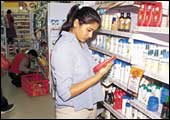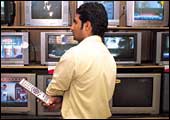 |
| Consumers' Paradise: Try snatching those
bags away and you'll know |
| 72 brands of toilet soaps. 12 brands of cars,
not counting sub-brands and models. Over hundred satellite channels.
Just what's your pick today? |
Fathom
this. Three decades ago, the Indian housewife had 11 brands of soap
to pick from, fixed grammage per bar. She now has 72 brands, in
assorted forms. The Indian officegoer had two brands of cars, three
boxes each-bonnet, cabin and boot. He now has 12 brands, not counting
the sub-brand models.
No, not to imply that the Liberalisation project
was kick-started 30 years ago; the Great Indian Brand Burst occurred
between the palindromic years of 1991 and 2002. Nor to imply that
counting bars and boxes is an appropriate way to measure freedom.
The issue is not the awesome variety of five-star
hotels, four-season resorts, three-box cars, two-piece suits or
even one-piece SIM cards for dropless global communication. All
these things make the consumer happy, and opposing them would be
an exercise in masochism. The issue is what all this choice means
to that elusive measure that marketers often call the 'quality of
life'.
Choice As Human Right
For ages, the Indian consumer could buy any
car he liked as long as it was white-and having it painted was the
shockwave-causing equivalent of appearing in public wearing, say,
a Lycra dhoti with loud checks. Those were the days that cars were
run till they rusted aground.
Today, people buy things they want, not what
they're forced to. An 800 gets replaced by a Santro not because
it's too creaky to run, but because the latter has entered the customer's
dreamspace. "With choice," says Radhika Roy, National
Qualitative Head, NFO MBL India, "the cycle of repurchase,
upgrading if you will, has become shorter, thus liberating the consumer."
 |
THE VALUE REVOLUTION
The biggest cause for celebration
is the expanding basket of products that price-based competition
has put within the reach of millions |
What's more, a white car these days almost qualifies
as a sort of statement-an attempt to stand out. Colour options?
You name it. A car these days would have to be plastered with scandalous
graffiti to raise eyebrows on the streets. Cars are no longer just
boxes on wheels ferrying people about, nor even mobility assurers.
They are turning into a way to express one's individualism. That's
what a bustling market can do. A market bustling with four-wheeled
sirens vying for your attention.
Feels good, doesn't it? Choice, in itself,
is liberation. "Ultimately," says Srinivasan Raman, Head,
Quest, ac Nielsen ORG-MARG, "exercising choice is empowerment."
The irony has been that a country enlightened
enough to adopt universal adult franchise as a matter of principle,
took so long to apply the same logic to consumption. Self-denial
was virtuous, as grandpa told us, but then it should have been self-denial
as chosen, not as compulsion.
It's a fine but crucial difference. Even the
ascetic who stays off all the wonders of a multiple choice lifestyle
ought to feel ennobled only if these soul-threatening wonders are
actually accessible. That's when that choice assumes validity-as
a willful decision taken after having examined all the other options.
"The consumer's assessment of product
performance, durability and affordability have changed because of
choice," says B. Narayanaswamy, Executive Director, Indica
Research. For once, consumer 'demand' actually means demand.
 |
THE SMORGASBORD OF
CHOICE
There are over 100 cable and satellite
channels and 22 terrestrial television channels available currently
in India, with something aimed at everybody |
Check out supermarket shelves. According to
K. Radhakrishnan, Vice President (Merchandising), FoodWorld Supermarkets,
"We have expanded our small imports counter to a full-fledged
imports department."
But do customers really bother to examine their
options? Often, yes. "There are very few categories in which
the consumer is unwilling to experiment," observes Roy. Even
otherwise, people must have these options. Because demand works
best as an invisible force, a force with its own dynamics. Of some
25 articles on a supermarket shelf, most customers may want to spend
their lifetimes with just one OL' familiar. There may be terrific
'value for money' in that purchase. But the very availability of
the other 24 options is also 'value' in a roundabout sort of way.
They, as competitors, set comparative benchmarks of value for the
OL' familiar-and thus act to regulate its performance.
So consumers may not behave like cola endorsers,
asking for 'more'. But if that 'more' suddenly becomes 'less', they
will notice-without doing the sums. They will not analyse the difference,
they will feel it. More than a decade since 1991, having experienced
competition, the Indian consumer will not settle for any less choice-and
that, perhaps, is the biggest vindication of a liberalised market
environment.
Zip Zap Zoom
If you really want to try a tricky experiment,
take TV. The choice in this arena has been explosive since satellite
dishes brought live CNN images of 1991's Gulf War straight into
Indian living rooms.
 |
A VERITABLE KALEIDOSCOPE
The variety of three-box cars,
two-piece suits, and one-piece SIM cards and just about anything
else has ensured that there will never be a dull moment in the
consumer's life |
In the years since that invasion, the 'remote'
has become a mission critical device in some 45 million homes- hardly
a wonder, given the virtual smorgasbord of choice in software programming.
There are over 100 C&S channels and 22 terrestrial TV channels
available currently in India, with something aimed at everybody-whatever
the demographics, whatever the psychographics. That this is the
world's most kaleidoscopic market is no exaggeration. A googa-geegee
show for a two-year-old? It's there. Reports from Liberia? It's
there. Daily enactment of ma-in-law management? There too. Wailing
electric guitars with spaced out lyrics? Got it. Something for someone
seeking enlightenment? Yes. For someone madly in love? Sure.
Now try narrowing this choice. Nobody can possibly
watch more than 75 per cent of those channels for more than a second's
worth of surf-through pixels. But try asking a dozen office colleagues
to submit signed-in-triplicate lists of which channels they want
to declare as 'wanted' and which they'd forgo-and watch the mayhem.
That's the funny thing about choice. It's hard to put down. Having
100 channels, three-fourths of them unwatched, is value in itself.
It gives us the freedom to zap channel-to-channel, and even a second's
peek at a neighbour's choice-which we halo'd souls are too virtuous
to watch-has its own gratification.
What the television remote is at home, the
cellular phone has become outside-something to keep clutched. Till
the consumer didn't have this little contraption, the old coiled
telephone did just fine. But now that she has it, try prying it
away from her. Feel like a stroll to the corner cafe to finish that
book? Feel free. You wouldn't have gone missing. Just had this bizarre
thought you want to share with someone? The keypad's all yours.
Want to switch to 'vibe' instead of 'ring' mode? Just a flick away.
The Indian mobile base is already 15-million strong, two-thirds
of whom have opted for the pre-paid card option-an idea thrown up
by the private sector rivalry for numbers. That's something to think
about.
Access, Access, Access
At the end, the biggest cause for celebration
is the expanding basket of products that price competition has put
within the reach of millions. Low-cost shampoo sachets of have empowered
village women to use glamour as a weapon in the marriage arena.
Small-pack biscuits have given village-to-village trudgers a portable
energy booster.
There are no bar codes in this part of India,
and the demand signals often gets muffled along the way. But there
are a lot of things the Indian villager would want to do if he could:
Just because.
-additional reporting by Nitya
Varadarajan
|
